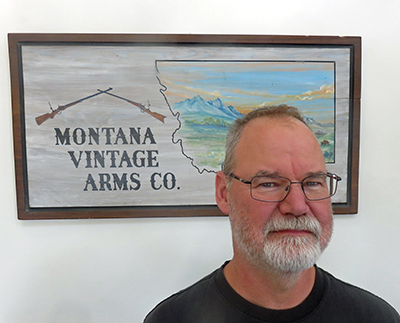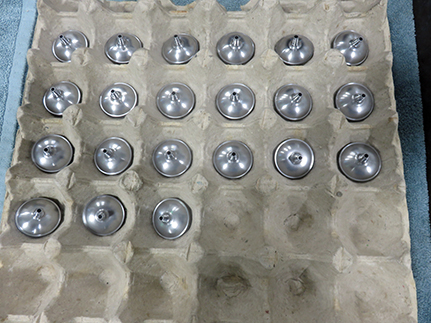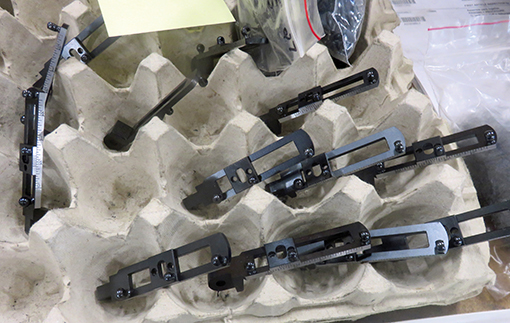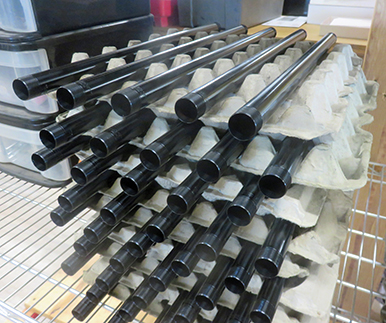A Visit with Montana Vintage Arms
feature By: Mike Nesbitt | September, 24

The first thing I inquired about was their newest rifle sight; a tang-mounted peep sight designed especially for muzzleloading rifles. This sight caught my interest for two very good reasons. First, my right eye is finding it harder to see an open sight on the rifle’s barrel clearly; a peep sight, which is looked “through” and not “at”, helps me a great deal. Second, I’m just starting to re-build an old 50-70 Springfield rifle into a Gemmer/Springfield (which will look like a Hawken rifle) and my thoughts of putting one of the new MVA Muzzleloader sights on that gun are foremost in my mind. The new MVA Muzzleloader sight could be inlet into the top of the wrist on the stock, just behind the tang, and it would be mounted very much like the peep sights were on the old 45-70 1873 Springfield Officer’s Model. The MVA “Muzzleloader Sporting Sight” is priced at $195.

As we went on to look at other items in the works, I was able to meet and shake hands with Reece Dringle. Reece is an outstanding member of the MVA crew, in my opinion, because the Series 7000 scope (which I have on my 45-90) had the mishap of losing the two small screws that hold the internal focusing lens in position. How this occurred, I really don’t know. The rifle and scope worked just fine with the first shot from the bench but taking the second shot, the scope could not be seen through. If there is any blame for this, that blame should fall on me and not on the scope.

We were able to stop and look at some midrange sights being assembled, or at least one step along their way to being finished. As the photo shows, the midrange sight “ladders” have been blued and a couple of the smaller pieces are already attached.
One very impressive point about our tour was the very modern tools and machinery that are used to make the MVA sights. A number of those machines were idle and Jim explained to us that he didn’t have enough operators to keep everything running at the same time. With the staff that Jim has, operators must work in stages, working on one machine until that stage of work is done, then moving to the next machine as the work progresses.

When we started talking about scopes, I asked Jim about options for crosshairs. My reason was that I’d prefer some thicker or heavier crosshairs, especially in my 6X scope, because my eye tends to lose sight of the crosshairs against a target. I specifically asked Jim about the possibility of getting stadia crosshairs. These have more than one horizontal crosshair so different distances can be shot without adjusting the elevation setting of the scope. My older RHO scope has a stadia crosshair; it adds to the flexibility of the scope and can act as a bit of a range finder, which is useful in hunting.

As mentioned earlier, the scope tubing that Montana Vintage Arms uses is purchased from other sources, as well as the lenses. All other pieces for the scopes and the intricate mountings are made by MVA. For our last stop on this tour, we went upstairs to where the scopes were assembled and shipments are prepared. There I saw a number of the 23-inch scope tubes being readied for their internal parts and end fittings. The popularity of the 23-inch scope is easily understood, and after using the 10X scope on a 45-70 Sharps, I prefer the shorter scope rather than the models that extend to the muzzle of the rifle.
Jim answered our final questions and briefly told us about some items that are still in the works. After this tour, I am sure it can be said that all of the MVA products are made to very high standards, and the buyer can expect a lifetime of excellent service. Montana Vintage Arms doesn’t have an actual showroom at the shop, so the best way of seeing their products is to visit their website at MontanaVintageArms.com. They are located at 61 Andrea Dr., Belgrade, Montana 59714, and can be contacted by phone at 406-388-4027. We certainly enjoyed “seeing the sights” at MVA!


